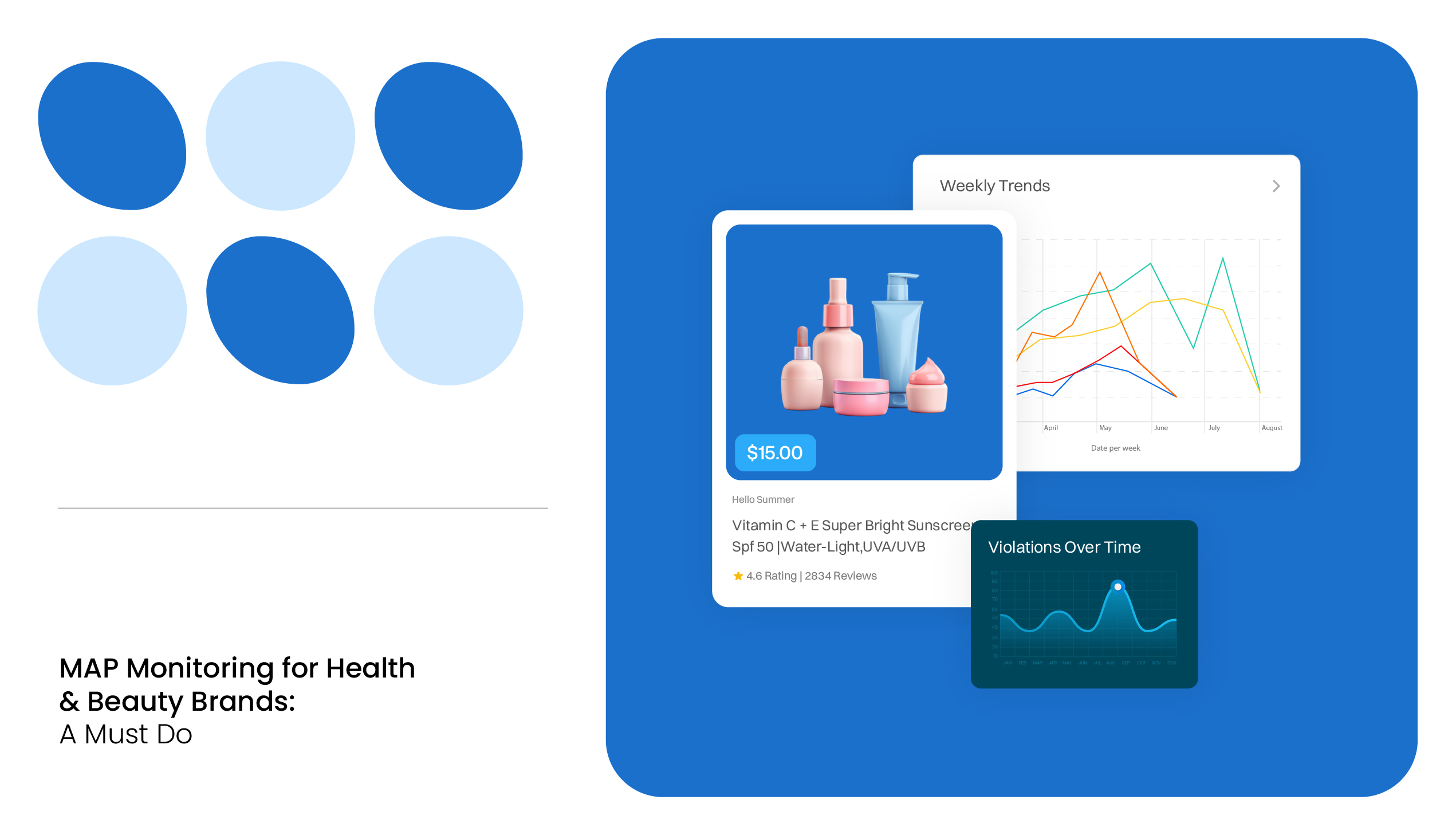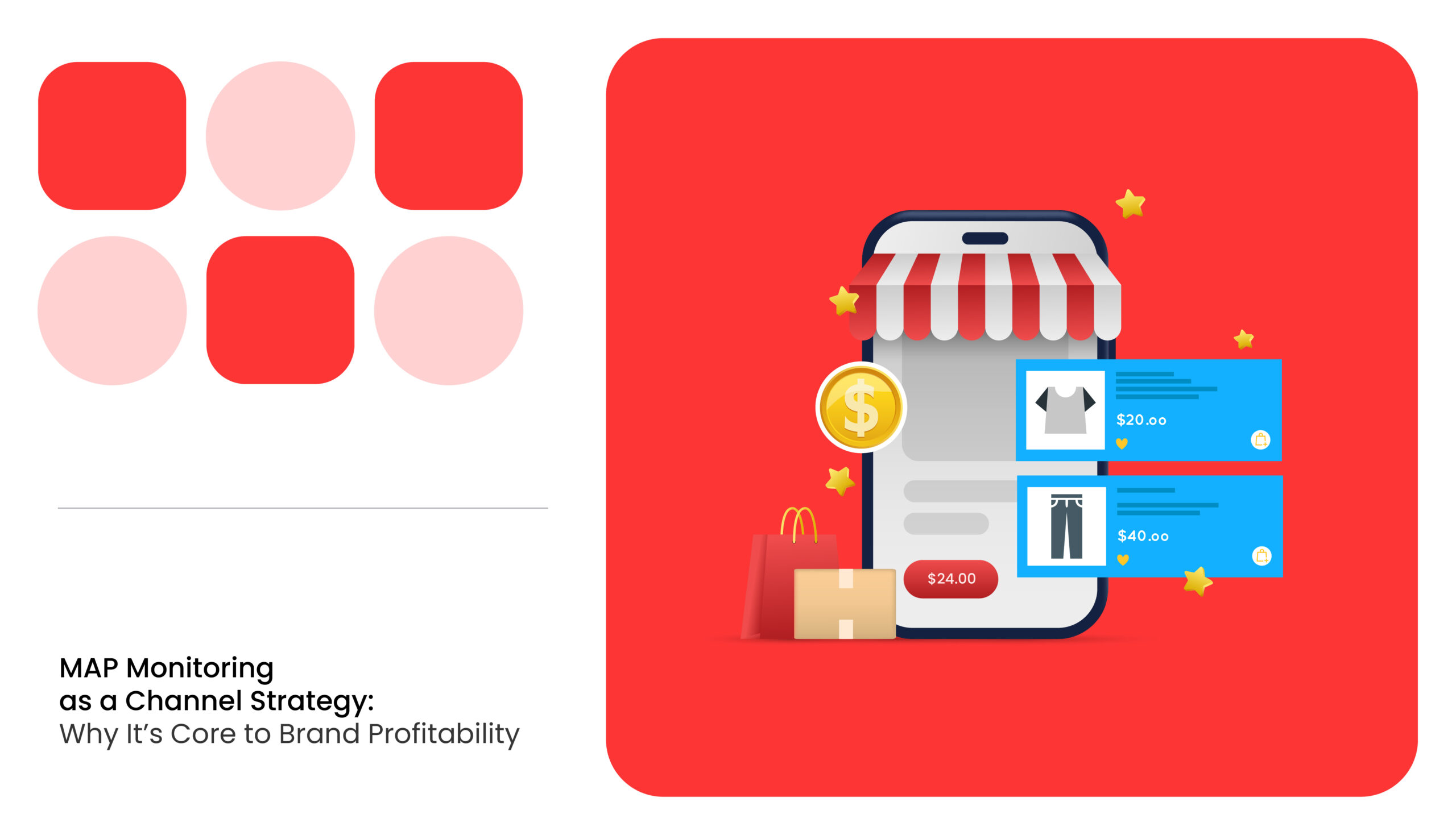You list a product at $29.99 across your channels. It’s your bestseller. However, on one marketplace, a seller drops the price to $22.99 without notice. No one flags it for 10 days. Resellers start matching the lower price. Competitors pounce. Your revenue tanks.
This isn’t a hypothetical; it’s exactly what happens when CPG brands don’t monitor MAP weekly.
Weekly MAP tracking benefits for CPG go beyond pricing control. It’s about protecting your brand’s value, profitability, and distributor network.
Let’s break down what’s really at stake when CPG brands don’t monitor MAP weekly.
Why CPG Brands Need Minimum Advertised Price Tracking in 2025?
Price is perception. In today’s hyper-transparent e-commerce landscape, shoppers can compare listings in seconds. If your pricing varies wildly across channels or marketplaces, it undermines your credibility.
That’s where consistent MAP compliance for CPG brands comes in. MAP policies are designed to protect both brand equity and retailer trust. But policies alone aren’t enough; weekly enforcement is what keeps your pricing strategy from collapsing.
A monthly or ad-hoc review won’t catch violations in time. That’s why weekly price tracking for CPG brands has become the new standard.
For Legacy Brands: Safeguarding Long-Term Value
Legacy brands have established brand equity, premium pricing, and retailer trust. Without consistent MAP monitoring and enforcement, they risk losing these advantages to unauthorized sellers or fluctuating marketplace prices. Regular monitoring ensures that their hard-earned value and premium status are protected across all channels.
For Disruptor Brands: Establishing Pricing Control
New-age disruptor brands rely heavily on maintaining a premium perception to scale. Unauthorized sellers undermining their prices can quickly erode consumer trust and brand value. MAP monitoring ensures that pricing remains consistent, helping disruptors maintain control over their market positioning and credibility.
What Happens When CPG Brands Skip Weekly MAP Monitoring?
When CPG brands fail to monitor their MAP pricing, price violations often go unnoticed, leading to price erosion, marketplace exploitation, and damaged retailer relationships.
Let’s take a deeper look:
1. Price Erosion Happens Fast And Spreads Faster
The moment one listing undercuts your MAP, everyone else is watching: retailers, resellers, and competitors.
Authorized sellers don’t want to lose the Buy Box or sales volume. So they price match. Within days, your product is 15–30% cheaper everywhere.
This triggers:
- Lower margins on high-velocity SKUs
- Damaged relationships with premium resellers
- A perception that your brand is unstable or perpetually on discount
Without consistent MAP compliance for CPG, your teams miss the window to fix the problem before it becomes systemic.
READ MORE| Confused about how to deal with price erosion? Check out Overcoming Price Erosion: Strategies for Brands on Online Marketplaces.
2. Marketplace Sellers Exploit the Gaps
Unauthorized sellers thrive in gaps between policy and enforcement. They know most brands don’t monitor frequently, and they use that window to win the Buy Box at the lowest possible price.
Once they do:
- Shoppers flock to the cheaper listing
- Your authorized sellers get undercut and frustrated
- MAP violations damage your brand credibility
For legacy brands, these violations can lead to long-term relationship issues with authorized resellers who feel undermined.
For new brands, unauthorized sellers are often more aggressive in trying to win market share, so rapid detection is even more important to maintain control.
How weekly MAP monitoring helps CPG brands is by shrinking this window. Faster detection leads to faster takedowns. Over time, that creates a strong deterrent effect and strong price discipline across all marketplaces.
3. Retailer Relationships Take a Hit
Retailers follow MAP because they expect you to enforce it. If they see violations go unchecked, they:
- Push back on promotional support
- Demand price concessions
- Rethink their partnership
![]()
In the seventh episode of the Digital Shelf Insider Podcast, Matthew Kelly, the Head of Commerce at PRECIOUS, sheds light on the transformational role of AI, the importance of digital shelf optimization, and the key strategies that CPG brands should employ to scale across leading platforms like Amazon, Walmart, and Target.
Listen to the full episode here:
MAP isn’t just a policy; it’s a signal of professionalism and reliability. If your enforcement is inconsistent, your relationship with retailers becomes unstable.
Consistent MAP compliance for CPG brands builds credibility and trust. It shows your partners that you’re serious about protecting mutual profitability and healthy pricing ecosystems.
4. Brand Perception Starts to Break Down
Today’s shoppers are savvy. They’ll notice when your product is $49.99 on your DTC site, $39.99 on Amazon, and $34.99 on Walmart.
This pricing inconsistency:
- Confuses buyers and delays purchase decisions
- Encourages them to wait for discounts
- Damages your premium positioning
For both legacy and new-age brands, inconsistent pricing sends the wrong message to consumers. This breakdown in price consistency harms your competitive position and erodes brand trust, especially for those new in the market fighting to build a premium image.
Pricing is one of the most powerful brand signals. If you’re not ensuring minimum advertised price tracking regularly, you’re allowing third-party sellers to control how your brand is perceived.
Want Ultimate Control Over Your Brand’s Value? Try Our MAP Monitoring Solution! [Take Action Now]
5. TTR Increases And Disintegrates Price Control
Time to Resolution (TTR) is a key operational metric. It tracks how long it takes to detect and resolve a MAP violation. The longer it stretches, the more money you lose.
Without weekly price tracking for CPG:
- TTR can exceed 10–15 days
- Violations remain active across marketplaces
- Revenue losses compound
With weekly alerts and structured MAP enforcement, you can cut TTR to under 48 hours. That’s the difference between minor pricing slippage and full-blown channel disruption.
READ MORE| Can’t figure out which MAP monitoring software to choose? Here are the Best MAP Monitoring Software You Should Consider for E-Commerce
How MetricsCart Helps CPG Brands Stay in Control
Whether you’re a legacy brand with years of market presence or a new-age disruptor aiming to capture market share, MAP tracking is crucial for both.
MetricsCart’s MAP monitoring software is purpose-built to empower CPG brands by automating MAP monitoring and enforcement. It provides critical insights that ensure consistent pricing and brand integrity.
![]()
Here’s how it protects pricing control and unlocks the weekly MAP tracking benefits for CPG:
- Real-Time + Weekly Monitoring: Track MAP violations on marketplaces like Amazon and Walmart in real-time, with weekly MAP compliance reports for actionable insights.
- Automated MAP Violation Detection: Automatically scan for price violations across thousands of listings. Flag unauthorized sellers and trigger alerts to take quick action.
- TTR Benchmarking and Alerts: Track and reduce your Time to Resolution. Set thresholds for automated workflows to maintain strong price control with consistent MAP compliance for CPG brands .
- Violation Trends & Compliance Analysis: Track recurring violations, identify high-risk periods, and categorize sellers into compliant and non-compliant groups for proactive enforcement.
- Evidence Collection & Actionable Insights: Automatically collects screenshots of violations, ensuring reliable documentation for dispute resolution, and provides clear insights for faster corrective actions.
- Tiered MAP Enforcement with Automated Email Notices: Automates a tiered enforcement process, sending notices, reminders, and final warnings to unauthorized sellers with predefined MAP violation e-mail templates. This ensures timely escalation and resolution with minimal manual effort.
Weekly price tracking for CPG is no longer optional, and using MetricsCart for MAP monitoring and enforcement makes it practical.
Closing Notes
CPG brands spend millions building value. But that value can erode in days if pricing discipline breaks down and leads to lost brand control and price wars.
Weekly MAP tracking is your brand’s first line of defense. It helps you catch violations fast, reduce your TTR, and maintain a consistent, trustworthy price presence across channels.
Book a free demo to see how MetricsCart helps leading CPG brands automate minimum advertised price tracking, ensure consistent MAP compliance, and gain the weekly MAP tracking benefits for CPG success.
Time Is Ticking! Protect Your MAP and Secure Your Brand’s Pricing Integrity!
FAQs
The Minimum Advertised Price (MAP) ensures that a brand’s products are not advertised below a set price, maintaining pricing integrity across all sales channels. MAP protects profit margins, prevents price wars, and ensures the brand is perceived as valuable, rather than constantly discounted.
MAP violations occur when a retailer or seller advertises a product below the agreed-upon minimum price set by the brand. These violations can damage brand perception, erode margins, and disrupt retailer relationships, ultimately harming the brand’s positioning and profitability.
Weekly MAP monitoring allows CPG brands to detect pricing violations quickly, preventing small pricing discrepancies from escalating. By identifying violations early, brands can take swift corrective action, stopping price erosion before it spreads across platforms and undermines their pricing strategy.
CPG brands should track MAP at least weekly to stay ahead of violations. In fast-moving e-commerce environments, daily monitoring can be ideal, but weekly checks are the minimum to ensure pricing consistency, protect margins, and maintain market fairness.
Consistent MAP tracking helps CPG brands protect brand value by maintaining premium pricing, boost profitability by reducing margin loss from price drops and unauthorized sellers, and strengthen retailer trust by ensuring fair pricing. It also improves operational efficiency with automated tools that speed up violation detection and enforcement, saving time and minimizing manual effort.






